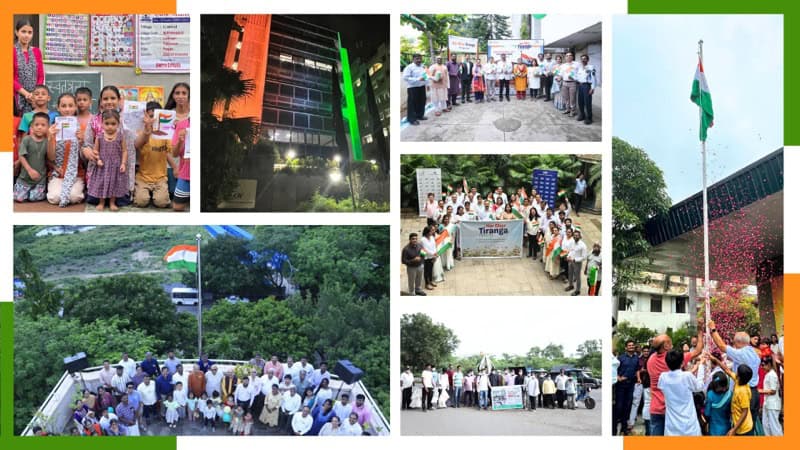— Shiva Keshavan, 6-time Olympian, 4-time Asian Champion & Head Scholarships, Olympics Sports Strategy, Reliance Foundation
Looking back on your remarkable career as a six-time Olympian and four-time Asian Champion, what inspired you to pursue luge as a sport, and how has your journey contributed to the landscape of winter sports in India?
My journey in luge began with a serendipitous encounter at the age of 15 as my talent was noticed by a former sporting legend working with the International Federation. However, I was already involved in practicing various sports and specially winter sports as I am born and brought up in the hills surrounding Manali, one of the premier winter sports destinations in India.
It was a blend of curiosity and a desire to break the mould that drew me to this unique sport. Over the years, my pursuit has been fuelled by a passion to defy conventional expectations and showcase India’s diverse potential and talent. My journey has been a constant pursuit of the realisation of the potential of winter sports in India and the great socio-economic benefit it can bring to individuals and communities in the mountain belt of our country.
By representing the nation in six consecutive Olympics and clinching four Asian Championship gold medals, it has hopefully brought some attention to this less known subject initiating the conversation around sports for development at both government and corporate levels while also giving confidence to young athletes that it is possible to aim for success in this field.
Enhancing India’s presence in global winter sports requires strategic planning and long-term commitment. Investments in research, technology, and international exposure for athletes are essential.
Being a 10 time Asian games medallist is a phenomenal achievement. What challenges did you face in maintaining such consistent success, and how do you think it has influenced the development of winter sports in Asia?
Consistency in the face of challenges and finding unique answers to these challenges in the Indian context has been a constant theme in my journey in Sport. The scarcity of winter sports infrastructure in Asia posed initial hurdles, however the abundance of natural infrastructure and potential for development provided the belief that in the near future we will have significant venues and destination in Asia for athletes and enthusiasts alike to enjoy the charm of winter sports.
The success has not only brought personal accolades but has also influenced the development of winter sports in Asia by setting benchmarks for aspiring athletes. It highlights the need for nations to invest in infrastructure, coaching, and athlete development programs to foster sustained success in winter disciplines. I am now on several high level committees in at the NOC in India working closely with the government to develop the Khelo India Winter Games 2024 and also at a continental level with the Olympic Council of Asia to host the Winter Asian Games in countries like China 2025 and Saudi Arabia, 2029!
How do you envision the role of private organizations in fostering sports talent and promoting a culture of sports excellence in India?
Private organizations play a pivotal role in nurturing sports talent and cultivating a culture of excellence. Their involvement is crucial in bridging the gap between grassroots potential and elite performance. While government is rightly engaged in infrastructure development required for widespread sport and hosting events, elite high-performance sport requires the unique focus and efficiency the private organizations are capable of providing.
Let us not forget that Sport is a great emotional connect between businesses and fans with inherent benefits for both. Collaborative efforts with the government can establish comprehensive programs focusing on skill development, infrastructure enhancement, and talent identification.
The private sector, with its resources and expertise, can act as a catalyst for creating a robust sports ecosystem, ensuring that talented individuals receive the necessary support to excel on the global stage.
What initiatives do you think are crucial to further boost the participation and performance of Indian athletes in winter disciplines, and how can the public and private sectors collaborate to support this growth?
Initiatives to boost participation and performance in winter sports require a multi-faceted approach. Investment in state-of-the-art facilities, access to quality coaching, and exposure to international competitions are imperative.
Master planning is required in mountain and winter sport destination wherein a wholesome approach is adopted for year-round utilisation of the infrastructure. There needs to be significant attention to safeguarding the fragile ecosystems that enable this industry to flourish. All this is possible only through collaboration of public and private sector.
From a performance perspective, winter sports must be given the same funding and support currently given to summer sports to replicate the recent growth and success of our athletes. The regulatory framework for winter sports needs a complete overhaul as we must recognise the unique challenges of this sector with regard to summer sports that have a wider geographical reach in our country.
With such an illustrious career, what legacy do you hope to leave behind, and what goals do you have for India@100?
Winter sport is a powerful medium for ushering in economic development and social mobility for a large section of society particularly in the mountain belt. Much more than the competitive aspects of sport, I would like to see activity-based tourism bringing in Jobs for local communities, physical activity to contribute to the healthy lifestyle of our youth and to reduce the dependence of drugs that is rapidly becoming an epidemic in many parts of the country.
Looking ahead to India@100, my vision is for a robust winter sports infrastructure, a flourishing talent pool, and a nation that embraces the spirit of sportsmanship. I aspire to see India as a force to be reckoned with on the global stage, not just in luge but across various winter disciplines.
As the Nation of the mighty Himalayas, there is no doubt that we have an opportunity to take a leadership role in winter sports in the region and create a robust industry that greatly impacts the lives of not only the 50 million or so people residing in the mountain belt but also to engage with the rest of our population through tourism and sport.
My legacy aims to transcend medals and records, aspiring to instil a passion for winter sports across the nation. I hope to be remembered as someone who broke barriers and paved the way for a new era in Indian sports.
How do you think India can enhance its presence in global winter sports, and what steps can be taken to bridge the gap between Indian athletes and the world’s best in luge and other winter disciplines?
Enhancing India’s presence in global winter sports requires strategic planning and long-term commitment. Investments in research, technology, and international exposure for athletes are essential. Collaboration with established winter sports nations can facilitate knowledge exchange and skill enhancement. Additionally, promoting winter sports at the grassroots level, identifying talent early, and providing sustained support are critical.
Climate Change is an added challenge for winter sports so we need to make smart use of the latest technologies and planning to minimise such risks. Moreover we must use the lessons learnt from developed countries to start with best practices and use this opportunity to develop in a respectful and symbiotic way with the environment. Bridging the gap involves a holistic approach, combining governmental support, private investments, and international partnerships to propel Indian athletes into the top echelons of winter sports.
As a prominent figure in Indian winter sports, how do you believe athletes and sports organizations can actively engage with local communities to promote winter sports awareness, garner support, and encourage grassroots participation in these less conventional sports?
Athletes and sports organizations can actively engage with local communities to promote winter sports by becoming ambassadors for change. Initiatives like community workshops, school programs, and interactive events can raise awareness and garner support. Establishing winter sports clubs and leagues at the local level can create a sense of belonging and encourage grassroots participation. By connecting with communities, athletes can inspire the next generation and build a foundation for sustained growth in less conventional sports. Collaborative efforts between sports organizations, local authorities, and educational institutions can pave the way for a cultural shift towards embracing winter sports in India.





